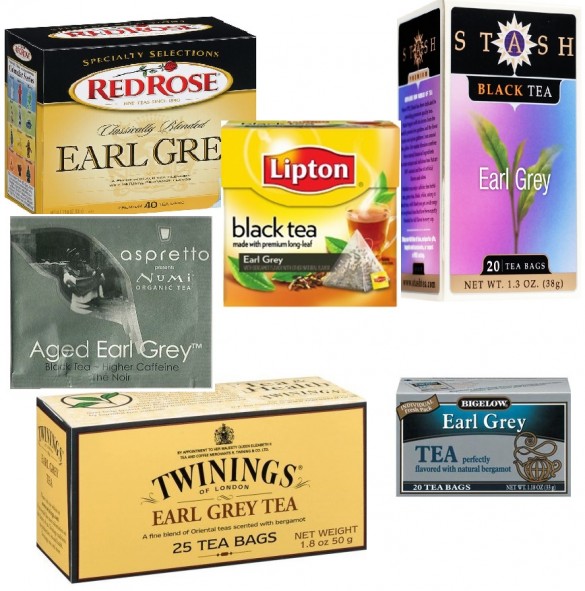 Almost anyone who drinks tea has at least tried Earl Grey. Every brand makes its own version, and each has its differences in taste, smell, color, etc. However, it takes a truly refined palate to really appreciate and compare these often subtle variations. While we lack such a thing here at the Geeky Gentleman, I still decided to try my own blind taste test of some common brands found at your local supermarket.
Almost anyone who drinks tea has at least tried Earl Grey. Every brand makes its own version, and each has its differences in taste, smell, color, etc. However, it takes a truly refined palate to really appreciate and compare these often subtle variations. While we lack such a thing here at the Geeky Gentleman, I still decided to try my own blind taste test of some common brands found at your local supermarket.
First, a few words about Earl Grey. It dates back to the first uses of oil of bergamot (a citrus fruit somewhere between an orange and a lemon) to flavor Chinese black tea leaves in the 1820s. The actual commercial origin of Earl Grey is disputed, but the Grey family claims that it was the work of a Chinese envoy visiting the family estate who used bergamot to “offset the preponderance of lime in the local water.” From there, it was Twinings that began marketing it as what we would call a brand.
While I had tried some of the six brands before (and, in the interest of full-disclosure, had a preference for Twinings), I approached the taste test as objectively as possible. First, I made sure not to consume not only Earl Grey, but any black tea for a week before the testing. Identical white cups were used to allow easy and clear color assessments, and, of course, I was presented with the teas one by one in a random order and not told which was which. All teas were steeped for five minutes and tasted without any additions (sugar, milk, etc.). Below are a few notes for each brand.
 The first tea I tried was Lipton’s Earl Grey. I was impressed by the almost floral/lemony (somehow these go together, I promise) scent of the bergamot and its bright, reddish color. If a tea could look brisk, this one certainly did. The taste matched the visual impression: Not only was the black tea balanced by the bergamot, but that briskness minimized its bitterness.
The first tea I tried was Lipton’s Earl Grey. I was impressed by the almost floral/lemony (somehow these go together, I promise) scent of the bergamot and its bright, reddish color. If a tea could look brisk, this one certainly did. The taste matched the visual impression: Not only was the black tea balanced by the bergamot, but that briskness minimized its bitterness.
Twinings was next. It had what I’d call a very slight “smoky” undertone beneath the bergamot aroma, and its color was a darker brown/mahogany. As for the taste, I found it a bit dull and to have a slight “flatness:” bergamot without the briskness. It was by no means bad, but it did seem to lack unique character.
Red Rose followed with an even darker color, almost opaque in the cup. It did not have a strong scent, and the bergamot aroma was very faint. If anything, it seemed to smell more like English Breakfast or some other basic black tea. It was notably bitter, and the bergamot taste was as faint as the scent. Clearly it’s the flavor of the original tea leaves that were the stars here. Aside from that bitterness, Red Rose was quite plain.
Aspretto’s “Aged” Earl Grey, a common brand found in college dining halls across the Northeast, had a dark color as well, but still maintained a red hue. Again the scent of bergamot was faint, and while the tea was not particularly bitter when sipped, its aftertaste was. Aside from this, it was dull, and the bergamot really had to fight to get out.
Bigelow’s Earl Grey had a medium brown color and a solid bergamot scent with what I can only call a “verdant” undertone that I found very appealing. Its taste was also more complex, with very low bitterness and good balance between the tea leaves and the bergamot, each adding just enough of its own qualities to the blend.
The final brand, Stash, had a very dark color, almost the same hue as your generic cola. Its scent seemed almost perfumed and had an “edge” to it that actually came across as pungent. It was not dull, but the taste (like the scent that it reflected) seemed to overpower the leaves. This use of bergamot is too strong for Earl Grey, at least in my opinion, and it resulted in an unpleasant experience.
In terms of superlatives, I’d have to say that, taken black, my favorite was the Bigelow followed closely by the Lipton. While, as already mentioned, my avowed favorite had been Twinings, here I found it at best in third place. However, it’s important to note that bagged teas were exclusively used in this test, and the loose-leaf Twinings Earl Grey has a much more robust flavor (as loose-leaf tea generally does).
Overall, my least favorite was Stash. The perfumed scent (and taste) was just not my cup of tea.
Of course, these are just the opinions of a single individual, so we encourage you to try as many brands as possible. The hope is that this serves as a starting point for those looking to be more discerning even in the most basic and commercial of teas.
Feel free to comment below with your own observations and preferences.
